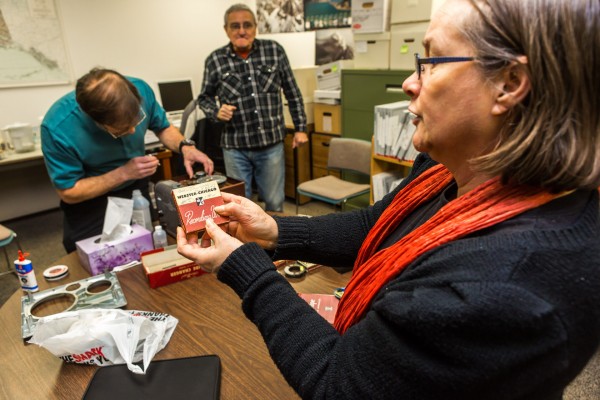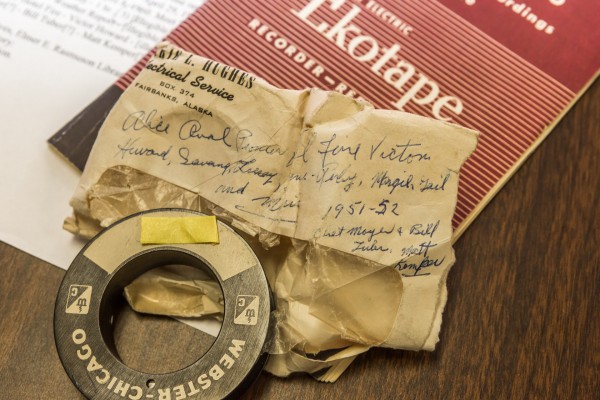–‘”˚…Á archivists work to preserve obsolete recordings
February 24, 2016
Jeff Richardson
907-474-6284
For decades, an old Webster-Chicago Electronic Memory recorder led a surprisingly
anonymous existence in a corner of –‘”˚…Á Rasmuson Library
archives.
The device is easy to notice. It’s the size of a brawny toaster and is covered with
a variety of old-fashioned switches, buttons and knobs. The file box it was stored
in also included eight recording spools scrawled with some brief but enticing descriptions,
such as “Gov. Mike Stepovich” and “Pioneer Hotel Fire.”

But it also came with a challenge — nobody knew whether the Webster-Chicago Electronic Memory recorder worked or how to use it. At some point Fairbanks historian Harrie Hughes had donated it to the library’s Alaska and Polar Regions Collections and Archives, but no instructions accompanied the gift. It arrived before the film archives were even established in 1993.
The scenario is surprisingly common for –‘”˚…Á archivists. They‚Äôre in an ongoing fight against aging audio and video formats, with the obsolete or obscure especially well represented.
“We have all kinds of stuff like this,” said Curator of Oral History Leslie McCartney with a smile. “You just open a box and there it is.”
The Electronic Memory recorder offered a particularly vexing problem. The machine, which was manufactured in the late 1940s, used technology that was employed for less than a decade. It preserved sounds by magnetizing a thin steel wire, a method that was soon phased out by magnetic tapes such as reel-to-reel and later cassette tapes.
A breakthrough arrived in the form of Art Thompson, the executive director for VFCM, a Nenana-based religious broadcaster. A former employee at the Multnomah University radio department in Portland, Oregon, Thompson became familiar with the old Webster-Chicago machines while transcribing Multnomah’s own collection of wire recordings.
In the process, Thompson grew fond of the sturdy machines. When he was told about –‘”˚…Á‚Äôs recorder, he agreed to check it out.

“They didn’t make a tremendous number of them, but so many have survived and are in working order, which is remarkable,” he said.
A crowd gathered on Jan. 22 in the library’s oral history offices to watch Thompson try to revive the old recorder. He pulled off the bottom panel to examine its 70-year-old wiring system, then cautiously turned the power knob on its face. A green light glowed on the front, providing the first sign that the machine still had life.
The room hushed when the motor began to purr, and the group let out a roar when the Webster-Chicago pumped out a big band tune recorded from an old radio program.
“You’d think we’re landing on the moon here,” joked George Lounsbury, an amateur historian who came to watch.
McCartney spent the following week transcribing most of the wire recordings, which will join a vast archive of historic materials that Hughes donated to –‘”˚…Á. Among his Electronic Memory reels, only the Stepovich recording was too fragile to play.
Lounsbury, a past president at Pioneer Igloo No. 4, said Hughes was obsessed with recording history. The longtime electrician, who died in 2006 at age 107, gave hundreds of old cassette tapes to –‘”˚…Á. The Webster-Chicago reels represented his earliest efforts at audio recordings.
“These were probably some of the first interviews he’d ever done,” Lounsbury said.

The wire recordings are classic Hughes, who was well-known for his brief, informal interviews with whoever he happened to encounter. He’d occasionally record commentary during long drives, describing street signs and reviewing roadside diners along the way.
Hughes’ wire recordings provided some interesting snippets, including comments from a hotel fire survivor and a song by ‘50s television star Gale Storm during a visit to Fairbanks. But the Hughes collection is more notable for offering context to another era, McCartney said.
“Even though he’s rambling through most of them, they’re priceless in what he was observing at the time,” she said.
–‘”˚…Á film archivist Angela Schmidt said the episode is also important because it preserves recordings that easily could have faded away. She credited Thompson with illuminating the mysteries of the Webster-Chicago Electronic Memory machine before it was too late.
“It’s just very fortuitous,” Schmidt said. “It might have been another 10 or 20 years before somebody came along.”


